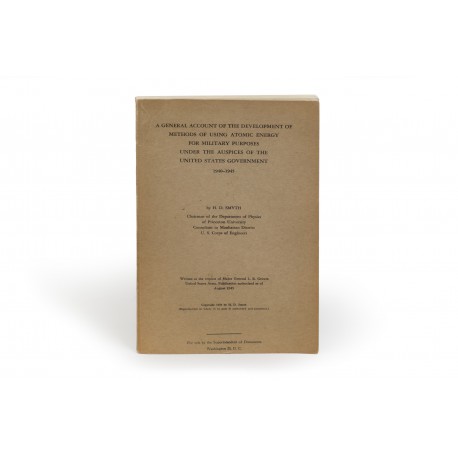 View larger
View larger
A General Account of the Development of Methods of Using Atomic Energy for Military Purposes under the Auspices of the United States Government, 1940-1945… Written at the request of Major General L.R. Groves, United States Army. Publication authorized as of August 1945
- Subjects
- Atomic bomb
- Science books - Physics, Atomic
- Authors/Creators
- Smyth, Henry De Wolf, 1898-1986
Smyth (Henry De Wolf)
Clinton, NY 1898 – 1986 Princeton, NJ
A General Account of the Development of Methods of Using Atomic Energy for Military Purposes under the Auspices of the United States Government, 1940-1945… Written at the request of Major General L.R. Groves, United States Army. Publication authorized as of August 1945.
Washington, dc: Government Printing Office, 1945
octavo (230 × 150 mm), paginated i–viii (including front wrapper), 1–182 (4). Colophon on p.182: ‘U.S. Government Printing Office: 1945 – 663817’.
Upper left corner bumped, otherwise in immaculate state of preservation.
Original printed wrappers.
The ‘Smyth Report’, a detailed account of the secret development of nuclear weaponry by the United States Government, was begun in the Spring of 1944 and completed in July 1945, by H.D. Smyth, chairman of the Department of Physics at Princeton University, an associate director on the Manhattan Project with this particular brief. It was released for publication by President Truman just a few weeks after the destruction of Hiroshima in substantially uncensored form, against the advice of the British and Canadian allies.
In compiling the Report, Smyth included as much technical detail as feasible, but aimed for a wider audience than nuclear physicists. He explains the contributions of the participating groups and laboratories at Berkeley, Chicago, Columbia, Los Alamos, and elsewhere, aspiring to place before the reader as many facts as possible about the bomb and inform discussion of the new political and social questions its development raised.
Apart from a mimeographed version classified as ‘top-secret’ and circulated among scientists involved in the project, the first ‘publication’ of the Smyth Report was in a hectograph reproduction from typescript distributed in a few copies at press conferences at the Pentagon on 11–12 August, 1945. On 13 August, in order to forestall any unauthorized claim to copyright, the Report was copyrighted in Smyth’s name. The present edition was published a few weeks later, about 20 September 1945, by the Superintendent of Documents, printing from a corrected copy of the hectograph document, and incorporating last-minute revisions.
The intention was to obtain the widest possible readership and this book has the statement ‘Reproduction in whole or in part is authorized and permitted’ prominently displayed on its front cover. In November 1945 the text was reprinted as volume 17, issue 4, of Reviews of Modern Physics, and an English edition by His Majesty’s Stationery Office appeared the same month.
In 1946 a Swedish translation was published at Stockholm and Russian (Moscow 1946) and Chinese (Chungking 1946) editions soon followed. Meanwhile, the Princeton University Press had brought out a commercial edition in a cloth binding. As the sole source of technical information about the atomic bomb, it went immediately into the best-seller lists where it remained for four months, eventually passing through eight printings and selling almost 127,000 copies.
For details of publishing history, see H.D. Smyth, ‘The “Smyth Report”’ in Princeton University Library Chronicle 37 (1975–1976), pp.173–189; Datus C. Smith, ‘The Publishing history of the Smyth Report’ (ibid.), pp.191–203; Rebecca Press Schwartz, ‘The Making of the History of the Atomic Bomb: Henry De Wolf Smyth and the Historiography of the Manhattan Project’, PhD thesis, Princeton University, 2008.
reference John Carter and Percy Horace Muir, Printing and the Mind of Man: A descriptive catalogue illustrating the impact of print on the evolution of Western Civilization during five centuries (London 1967), p.253 no. 422e



